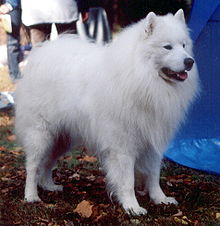Samoyed
The Samoyed is a breed of dog that takes its name from theSamoyedic peoples of Siberia. These nomadic reindeer herders bred the fluffy white dogs to help with the herding, and to pull sleds when they moved. An alternate name for the breed, especially in Europe, is Bjelkier.
Appearance
Size
Males typically weigh between 23–30 kilograms (51–66 lb), while females typically weigh 17–25 kilograms (37–55 lb).
Height:
AKC Standard : 21–23.5 inches (53–60 cm) at the shoulder for males, 19–21 inches (48–53 cm) for females.
UK Kennel Club Standard : 51–56 centimetres (20–22 in) for males, 46–51 centimetres (18–20 in) for females.
AKC Standard : 21–23.5 inches (53–60 cm) at the shoulder for males, 19–21 inches (48–53 cm) for females.
UK Kennel Club Standard : 51–56 centimetres (20–22 in) for males, 46–51 centimetres (18–20 in) for females.
Eyes
Samoyed eyes are usually black or brown and are almond in shape. Blue or other color eyes can occur but are not allowed in the show ring. It is in the "brown and black section" in its family, the Spitz family.
Ears
Samoyed ears are thick and covered with fur, triangular in shape, and erect. They are almost always white but can often have a light to dark brown tint (known as "biscuit"), usually around the tips of ears.
Tail
The Samoyed tail is one of the breed's more distinguishing features. Like the Alaskan Malamute, the tail is carried curled over the back; however, unlike the Malamute, the Samoyed tail is held actually touching the back. It should not be a tight curl or held flag-like; it should be carried lying over the back and to one side. In cold weather, Samoyeds may sleep with their tails over their noses to provide additional warmth. Almost all Samoyeds will allow their tails to fall when they are relaxed and at ease, as when being stroked or while eating, but will return their tails to a curl when more alert.
NZKC Standard: Tail: Long and profuse, carried over the back when alert; sometimes dropped when at rest.
UK Kennel Club Standard : Tail : Long and profusely coated, carried over the back and to the side when alert, sometimes dropped when at rest.
Coat
Samoyeds have a dense, double layer coat. The topcoat contains long, coarse, and straight guard hairs, which appear white but have a hint of silver coloring. This top layer keeps the undercoatrelatively clean and free of debris. The under layer, or undercoat, consists of a dense, soft, and short fur that keeps the dog warm. The undercoat is typically shed heavily once or twice a year, and this seasonal process is sometimes referred to as "blowing coat". This does not mean the Samoyed will shed only during that time however; fine hairs (versus the dense clumps shed during seasonal shedding) will be shed all year round, and have a tendency to stick to cloth and float in the air. The standard Samoyed may come in a mixture of biscuit and white coloring, although pure white and all biscuit dogs are common. Males typically have larger ruffs than females.
History
Samoyeds were used for sledding, herding, guarding and keeping their owners warm.
Fridtjof Nansen believed that the use of sled dogs was the only effective way to explore the north and used Samoyeds on his polar expeditions. His plan to feed the weaker dogs to the stronger ones as the former died during the expedition ultimately consumed nearly all of his dogs.
Roald Amundsen used a team of sled dogs led by a Samoyed named Etah on the first expedition to reach the South Pole.
Recent DNA analysis of the breed has led to the Samoyed's being included amongst the fourteen most ancient dog breeds,[22] along with Siberian Huskies, Alaskan Malamutes, the Chow Chow, and 10 others of a diverse geographic background. The Samoyeds have been bred and trained for at least 3,000 years.
 | ||||
| Other names | Bjelkier, Samoiedskaya Sobaka, Nenetskaya Laika | |||
|---|---|---|---|---|
| Nicknames | Smiley Sammy | |||
| Country of origin | Northwest Russia and WesternSiberia | |||
| Patronage | Nordic Kennel Union | |||
| ||||
| ||||



No comments:
Post a Comment